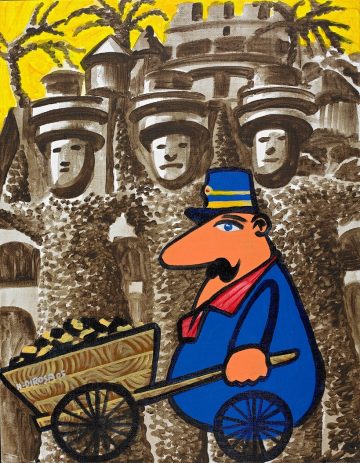Hervé DI ROSA 1959
Hervé Di Rosa was born in Sète in 1959. A member of the French Figuration Libre movement in the 1980s, his work often borrows from the codes of comics, rock and graffiti. A former student of the Ecole Nationale des Arts Décoratifs in Paris, he has practised all creative techniques: painting, sculpture, printmaking, fresco, lacquer, embossed silver, ceramics…. His creations are dense, expressive and filled with a certain irony. Often, dreams and nightmares depict a narrative universe, where the artist plays with an obvious grotesque. Since 1993, he has been touring the world with craftsmen to study how images are made elsewhere. In 2000, he founded the Musée international des arts modestes in Sète (MIAM).
More than two hundred solo exhibitions have made it possible to admire his work, which can be found in important public and private collections in Europe, America and Asia. In 2016, the Maison Rouge in Paris dedicated the exhibition Plus jamais seul. Hervé Di Rosa and the Modest Arts. It was possible to find his work at La Piscine de Roubaix during the exhibition Hervé Di Rosa: l’œuvre au monde in 2018. He has been represented by the Galerie Louis Carré & Cie since 1993.
Hommage au facteur cheval 2005
In Hommage au facteur Cheval, the artist has painted the postman posing in front of the eastern façade of his work. Drawn in his postman’s uniform, red collar and kepi on his head, the postman wears an imposing moustache, his nose is oversized and his belly round. Supporting his wheelbarrow, whose stones are yellowed as if they were gold ingots, he will soon resume his dynamic hard work. As if in osmosis with his tool, he has a wheel in place of his legs. In the background, the Three Giants protect the building against a bright yellow sky and at the top, the Barbary Tower is lined with exotic palm trees. The flat areas of bright colour make the more contrasting background more dynamic. Similarly, the rapid line of the postman’s drawing contrasts with the meticulous details of the giants’ bodies. Symbols of the palace, these giants named Caesar, Vercingetorix and Archimedes represent the brotherhood of Great Men. Some say that this is the only representation of Caesar and Vercingetorix on an equal footing. Here, the postman Cheval has joined these illustrious figures in all serenity. And this fraternity that he has so often proclaimed, and that Hervé Di Rosa also seeks in his travels around the world, seems to be granted to him at last.

